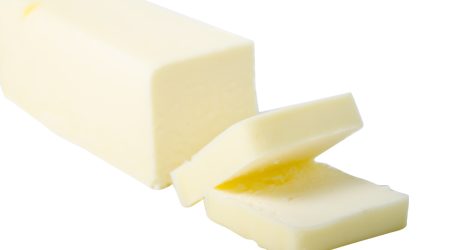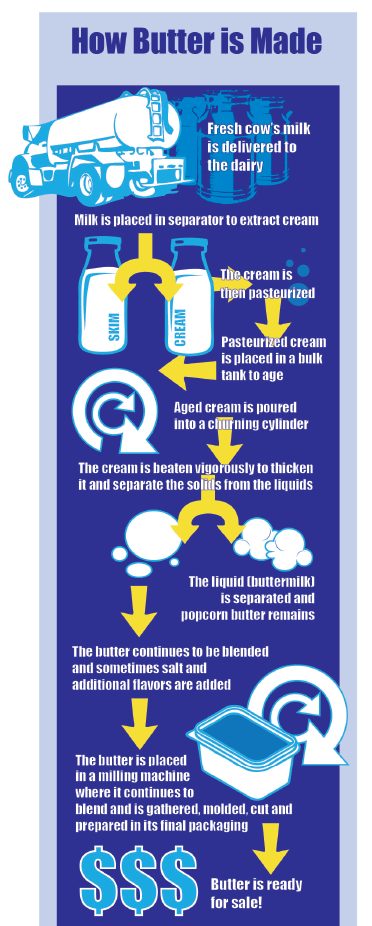Paul Child once said to Julia Child, “You are the butter to my bread, you are the breath to my life.” A beautiful quote and sincere statement of love with a lot of truth to it, because bread just isn’t as wonderful unless it’s accompanied by true, creamy, melt-in-your mouth butter. Butter is a quintessential ingredient in all kitchens from the top gourmet chef to the at-home cook, and anyone who argues that butter doesn’t belong is only depriving themselves (and their customers) of the true pleasures butter brings to recipes. Butter is a misunderstood necessity, really – it is natural, simple to prepare, has various culinary (and other) uses and even contains healthy benefits despite its bad rap. To know butter is to love butter.

The Basics of Butter
The United States Department of Agriculture (USDA) defines butter as a food product which is made exclusively from milk or cream, or both, with or without common salt, and with or without additional coloring matter, and containing not less than 80 percent by weight of milkfat. The cream used in butter must be separated from milk and derived from cows, and pasteurized to the USDA’s standards. Butter is then categorized into three grades which are determined primarily by flavor but also body, color and salt. Butter can be classified as Grade AA, the highest quality, followed by Grade A and Grade B – all of which are carefully defined by the USDA.
Breaking Down Butter
Butter is classified as a fat. It is an animal product and contains a high amount of saturated fat followed by both monounsaturated and polyunsaturated fats. Butter is high in dietary cholesterol. It also contains vitamin A, which is responsible for its general yellow color, as well as vitamins D, K2 and E. Based on the amount of vitamin A it can differ in colors and sometimes food coloring is added to maintain a consistent color throughout batches.
 The discussion on the health value of butter versus other similar spreads is still out for debate, but the basic composition of butter proves there are benefits. Fats in the diet are important for the absorption of essential nutrients and vitamins. Vitamin K2 is generally an under-consumed vitamin and helps with the absorption of calcium. Vitamin E aids the body’s absorption of vitamin K but is also an antioxidant that can protect tissues and the formulation of red blood cells. Vitamin D assists in calcium intake as well and strengthens bones. Vitamin A is responsible for maintaining healthy eyes, bones and skin. Also found in butter are conjugated linoleic acid, which prevents cancer cell growth and can aid in weight loss, and butyric acid, which can serve as an anti-inflammatory and help fight infection as well as impede weight gain and tumor growth. Nutritional guidelines show the key to ingesting fats is moderation, so when it comes to butter it’s best to adhere to the levels suggested.
The discussion on the health value of butter versus other similar spreads is still out for debate, but the basic composition of butter proves there are benefits. Fats in the diet are important for the absorption of essential nutrients and vitamins. Vitamin K2 is generally an under-consumed vitamin and helps with the absorption of calcium. Vitamin E aids the body’s absorption of vitamin K but is also an antioxidant that can protect tissues and the formulation of red blood cells. Vitamin D assists in calcium intake as well and strengthens bones. Vitamin A is responsible for maintaining healthy eyes, bones and skin. Also found in butter are conjugated linoleic acid, which prevents cancer cell growth and can aid in weight loss, and butyric acid, which can serve as an anti-inflammatory and help fight infection as well as impede weight gain and tumor growth. Nutritional guidelines show the key to ingesting fats is moderation, so when it comes to butter it’s best to adhere to the levels suggested.
An important fact to also keep in mind is that real butter is also a natural product, which cannot be said for all of the spreads on the market. When the process of making butter is managed, the nutritional value of butter can improve when the cows are grass-fed. Regardless of the process or claims against it, butter has been a diet staple in the lives of many for centuries and will only continue to play a major role in the food we eat.
Butter in the Kitchen, and Out of It
Some of the best things in life are made with butter. The biggest decision when using butter is to determine whether to use salted or unsalted – always consult the recipe before choosing. The most common use of butter is as a spread accompanying rolls, breads, bagels and muffins. Some take butter spreads to the next level by adding herbs, spices and infusions – one of the best combinations being truffles. In its simplest form it is also great for coating roasted turkeys and chickens as well as pans for baking to prevent sticking, or dipping foods such as lobster or crab. Sautéing and frying are another basic use where the butter is heated in a pan and cooked with anything from vegetables to steaks. Butter-based sauces such as hollandaise and buffalo are also delicious ways to enjoy its richness and flavor. The standard pastry uses include making laminated dough which is used for croissants, pie crusts, Danishes and puff pastries, preparing cookies, cakes and caramels, and frostings. The culinary applications for butter are truly vast, and always delicious.
Butter’s versatility extends outside of the kitchen too. Practical uses include removing sticky items, loosening rings, greasing a door, lock or hinge and removing ink from plastic. It can also be used in various beauty regimes including: softening cuticles and hands, conditioning hair, attempting a close shave in lieu of shaving cream and removing gum from hair. A dab of butter on freshly cut cheese and onions will help preserve each and prevent mold on the cheese.
Now that you know butter, doesn’t it make it easier to love? Maybe the quote from Paul to Julia should read, “Butter is the breath of life.”
